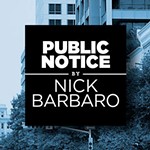Public Notice: Setting an Agenda for Land Use
By Nick Barbaro, Fri., June 3, 2022
City Council continues to make progress on its renewed push to improve land use regulations, focusing on two proposals that'll be on the agenda next week (June 9) regarding properties along the city's priority transit corridors. One is a largely technical fix to the city's vertical mixed-use ordinance, which is the city's most successful density bonus program – allowing bigger buildings on those corridors in exchange for affordable housing and other public benefits included in the project – but is limited by various factors in the way it's written. Hence VMU2, a rewrite spearheaded by Council Member Ann Kitchen, which has been in the works for months and is ready for adoption as Item 80 on the draft agenda. The second is a broader and less defined initiative (Item 66) to reduce compatibility limits and parking requirements for all properties along the transit corridors, not just those that are zoned for VMU. That one's not an ordinance yet, but if all goes well, it'll be a resolution asking city staff to develop something that Council can vote on in a few months.
CM José "Chito" Vela – last seen urging colleagues "not to make arbitrary decisions about how many feet to add or take away" from regulations without more study ("Council Recap: Affordability Crisis Challenges Neighborhood Protections," News, May 27) – came back a week later via the Council message board with a proposed amendment to the VMU2 ordinance that would cut the distance that compatibility is triggered from 540 feet to 100 feet for properties directly along the Project Connect rail corridors, and would reduce parking requirements for those properties to 25% of what would otherwise be required, or in some cases eliminate parking requirements altogether "if appropriate conditions are met," with those conditions not yet defined. Arbitrary or not, VMU2 sponsor Ann Kitchen promptly replied that she would accept that amendment, which is a good sign for broadening Council consensus. In practical terms, what it means is that if a site is already zoned VMU, and it's directly on a rail line, it can build out to whatever it's zoned for unless it's directly next to (or backs up to) to a single-family house. Whether that consensus is broad enough to get through the more wide-ranging Item 66 is an open question.
And as if to emphasize that this is a process and not a single action, that June 9 agenda is packed with other land use items, along with some 29 zoning and neighborhood plan cases, including the proposed development at 200 Academy, the old Austin Opera House, coming back for its climactic third reading.
In Item 39 from Housing and Planning, the department is recommending against letting a project near Plaza Saltillo pay a fee in lieu of providing affordable housing on-site. The developer is claiming that it's economically unfeasible to provide the housing, but they want the increased height, building cover, etc. that you get for including affordable housing, and city staff is, in this case, saying no to what they describe as "an office project" with a minimal amount of housing. If the city really wants to have at least a modicum of affordable housing in desirable, transit-rich areas, these voluntary density bonus programs are one of the few tools it has to make that happen, and they don't work if you don't enforce them. Still, some no doubt feel that any housing is better than none; it'll be interesting to hear the discussion on this one. In addition, Item 62 will make it easier to build accessory dwelling units by eliminating the parking requirement within a quarter-mile of a priority transit corridor or Imagine Austin Center and loosening some very arcane current rules on the placement of the units on the lot. Hooray. And Item 69 would ask the city manager to establish a "district level planning process," a baby step toward actual planning that the planning department has long said it has no time for.
Meanwhile, by the time you read this, "mayoral candidate Celia Israel will [have] announce[d] her bold plan to address the housing supply shortage and make housing more accessible for all Austin residents, including families, seniors and renters." That was this morning, Thu., June 2, at 10am, so maybe all that other stuff is moot by now.
Seriously, though, it'll be interesting to see what her take on this is, and whether there's actually a plan there or just a heavy dose of aspirational rhetoric. In any case, it's a bold political move on her part; if she goes up against former Mayor Kirk Watson in November (or a December run-off), her strengths as a candidate don't lie in knowing the nuts and bolts of city government, and there's nothing nuttier and boltier in city government than the Land Development Code and housing policy.
Neighborhood pools open next week – at least 10 of them, with another 19 facilities still awaiting lifeguards, whose hiring has been woefully slow (read more). Opening on Monday, June 6, are Balcones, Dick Nichols, Dove Springs, Garrison, Govalle, Montopolis, Northwest, Rosewood, Shipe, and Westenfield pools. For hours and other info: austintexas.gov/pools.
Austin's second official Nature Play Space opens on Saturday, June 4, at MLK Station Neighborhood Park, 2907 E. MLK, with an opening party from noon to 3pm. As part of a program to connect kids to nature, the space emphasizes natural elements: stumps, logs, boulders, limestone blocks, mulched trails, and stepping stones across the creek. Sounds nice, and kind of like a no-brainer, right? Perhaps PARD can think about incorporating some of these natural elements into their planning for larger spaces such as the Waterloo Greenway and Zilker Park.
Project Connect has finished its latest series of working group meetings, but the fun's not over yet: Leslie Pool will host a Community Meet and Greet this Sunday, June 5, 2-3:30pm at Black Star Co-op, with reps from Austin Transit Partnership, Cap Metro, and Project Connect discussing "the evolving design" for the Crestview Station, where the Red Line tracks will have to cross either over or under the Orange Line (read more). "Food served. Children welcome!" Then, the following week (Tue., June 14, 5:30pm), Project Connect presents the latest on the Drag, with traffic analysis, presumably of the staff's preferred plan to reroute all vehicular traffic off of the Drag and onto the streets farther west. Register or see the public engagement library of earlier reports at projectconnect.com/get-involved.
Got something to say on the subject? Send a letter to the editor.









